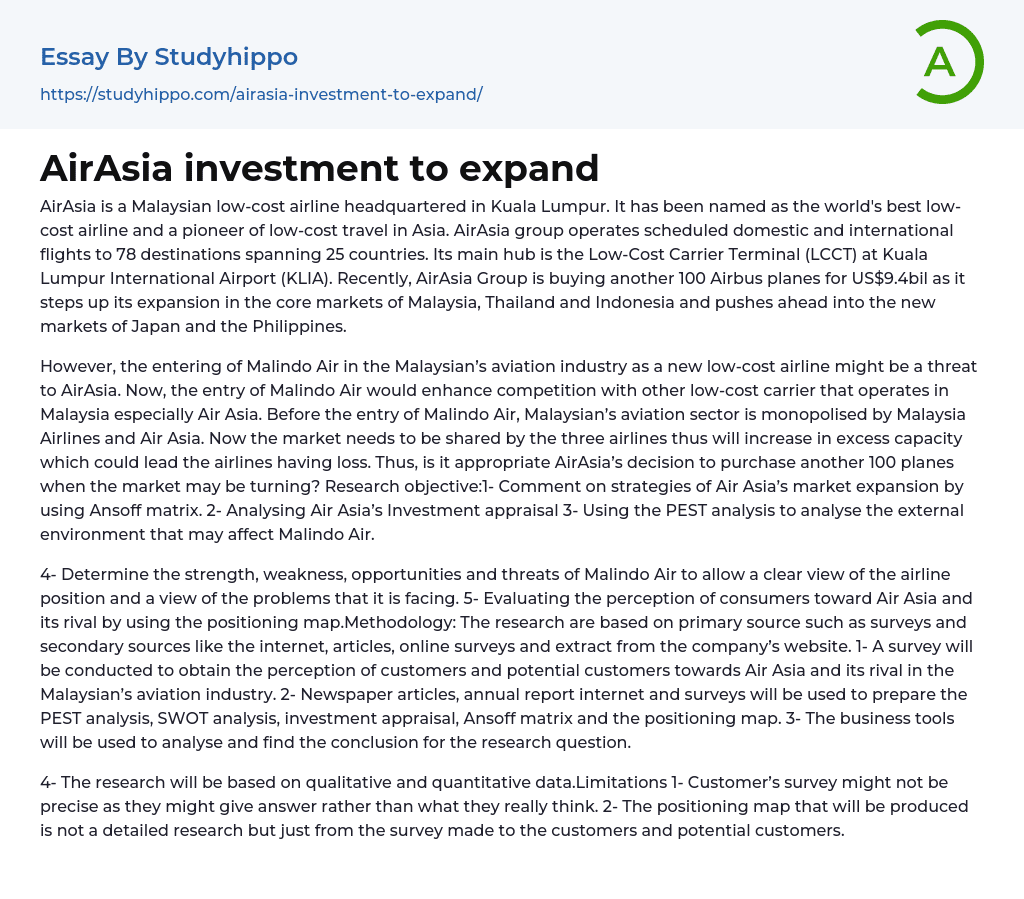AirAsia is a reputable low-cost airline based in Kuala Lumpur, known for pioneering affordable travel throughout Asia. Its services cover 78 domestic and international destinations across 25 countries, with the Low-Cost Carrier Terminal (LCCT) at Kuala Lumpur International Airport (KLIA) serving as its primary hub. To bolster its operations in Malaysia, Thailand, and Indonesia while exploring new markets like Japan and the Philippines, the AirAsia Group is investing $9.4 billion to acquire an extra 100 Airbus planes.
The emergence of Malindo Air as a new low-cost airline in Malaysia has increased competition within the budget carrier industry, potentially posing a challenge for AirAsia. Before Malindo Air's entrance, Malaysia Airlines and AirAsia had monopolized the aviation market in Malaysia. However, with a third competitor now involved, there may be an oversupply of capacity leading to financial difficulties fo
...r all airlines involved. This situation raises concerns about the wisdom behind AirAsia's decision to acquire 100 additional aircraft. In order to address these issues, this study examines how AirAsia plans to expand its market using the Ansoff Matrix, evaluates their investment appraisal strategy and analyzes external factors that could impact Malindo Air through PEST analysis.
The research methodology for this project includes various primary and secondary sources. To begin with, a consumer perception survey will be conducted to understand the views of customers and potential customers of Air Asia and its rival airlines in the Malaysian aviation industry. This will be complemented by a PEST analysis, SWOT analysis, investment appraisal, Ansoff matrix and positioning map, which will use sources such as internet articles, online surveys and extracts from the company’s website. By employing these business tools, we ai
to determine the strength, weakness, opportunities and threats faced by Malindo Air, and provide a clear view of its current position and problems. Additionally, we will evaluate consumer perceptions toward Air Asia and its competitor using the positioning map.
The study will incorporate qualitative and quantitative data with two important caveats. Firstly, the accuracy of customer survey results may be limited if participants do not provide truthful opinions. Secondly, the positioning map that results from survey responses collected only from customers and potential customers will not represent a complete analysis.
- Investing essays
- Asset essays
- Depreciation essays
- Discounted Cash Flow essays
- Foreign Direct Investment essays
- Funds essays
- Internal Rate Of Return essays
- Revenue essays
- Day Trading essays
- Futures Trading essays
- Capital market essays
- Million essays
- Payment essays
- Rate Of Return essays
- Funding essays
- Hedge Fund essays
- Cars essays
- Bicycle essays
- Rms Titanic essays
- Renault essays
- Truck essays
- chrysler essays
- The city essays
- Racing essays
- Aviation essays
- Emergency Management essays
- Health Insurance essays
- Insurance essays
- Life Insurance essays
- Public Transport essays
- Transportation essays
- Bank essays
- Banking essays
- Corporate Finance essays
- Credit Card essays
- Currency essays
- Debt essays
- Donation essays
- Enron Scandal essays
- Equity essays
- Financial Accounting essays
- Financial Crisis essays
- Financial News essays
- Financial Ratios essays
- Financial Services essays
- Forecasting essays
- Foreign Exchange Market essays
- Free Market essays
- Gold essays
- Investment essays




